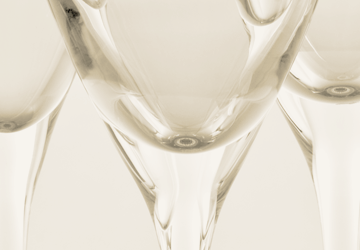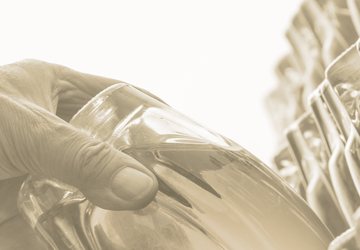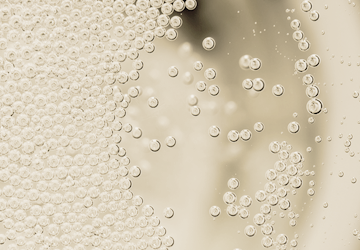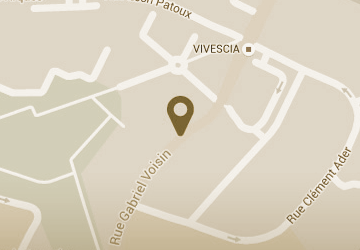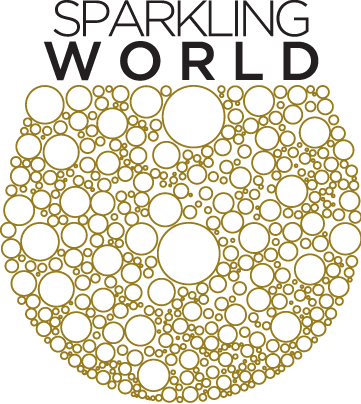Champagne production
The process for making Champagne is known as the Méthode Champenoise or Champagnisation and its distinguishing feature is the creation of effervescent wine through secondary fermentation in the wine bottle.
Appellation d'origine controllée (AOC) Champagne protects both the use of the name Champagne and the term Methodé Champensoise. Other sparkling wines produced by the same method, but outside the AOC areas, display one of the following alternative terms on the wine label to indicate the fact: Crémant, Méthode Traditionnelle, Metodo Classico or Traditional Method.
Alternative methods for making sparkling wines include:
- Carbonation or gasification – the injection of carbon dioxide (CO2) into wine (similar to the production of fizzy drinks).
- Metodo Martinotti or Méthode Charmat – the secondary fermentation takes place in large vats and the sparkling wine is then bottled under pressure.
- Ancestral Method – the wine is bottled before alcoholic fermentation has been completed. The vinification process is then terminated in the bottle to create the effervescence.
A step-by-step guide to the various Champagne-making phases follows. It has been divided into 3 sections to facilitate reading. Many of the steps are strictly regulated by the AOC Champagne and more detailed information about them can be found in the other chapters of the Learning section of the website.
Grape Harvest
- The dates for harvesting are set by the governing body for each grape variety in each village.
- Grapes are considered to be mature when they have reached a level of 143g of sugar per litre of grape must and a minimum alcoholic strength by volume of 9%.
- Grapes are harvested manually and placed in approved containers before being transported to be pressed.
- The grape varieties grown in Champagne are: Arbane (white), Chardonnay (white), Meunier (black), Petit Meslier (white), Pinot Blanc (white), Pinot Gris (grey) and Pinot Noir (black).
Pressing
- Grapes are weighed before pressing and are pressed whole.
- Grapes are normally pressed separately for each grape variety and for each vineyard plot to preserve their individual characteristics.
- Press capacity can vary from 2,000kg to 12,000kg.
- Grapes are pressed to produce 25.5 hectolitres from a 4,000kg load of grapes. The first 20.5 hectolitres of grape must produced are known as the cuvée, while the next 5 hectolitres, the taille, are collected separately. Both can be used to make Champagne.
Decantering (Debourbage)
- The grape must can be treated with sulphites (optional) to avoid the risk of oxidation. SO2 is used for its antiseptic, antioxidant and clarifying characteristics.
- Clarification of the grape must allows the solid particles present to fall (by gravity) to the bottom of the tank.
- The clear grape must is pumped into new casks for vinification, while the residual sediments are sent to be distilled (before mid December of the current year).
Chaptalisation / Enrichment (optional)
- The addition of sugar to the grape must is authorised in Champagne to increase alcoholic strength by volume by no more than 2%.
- I6.83g/l of sugar are required to produce an increase of 1% vol of alcohol.
- The grape must cannot increase in volume (by adding sugar) by more than 1.12% for a 1% increase by vol of alcohol.
Yeast selection (optional)
- Yeasts were present on the grapes in the vineyard and have been transferred during pressing into the grape must.
- Different yeasts present in the grape must can be selected to be used for the vinification process, or the process can be totally spontaneous.
Alcoholic Fermentation
- The fermentation of the grape must is aided by the presence of the yeasts that convert the sugar into alcohol.
- The base wine produced is known as Vin Clair in the Champagne region.
Malolatic Fermentation (optional)
- Malolatic fermentation converts malic acid into lactic acid. This process occurs naturally in springtime when the warmer weather activates the enzymes present in the wine.
- Lactic acid is creamier, so it will add smoother characteristics to the final Champagne.
- Malolatic fermentation can be blocked by adding a larger quantity of SO2 prior to vinification, or by controlling the temperature of the thermostatically controlled casks.
- A recently introduced technique uses the natural heat generated during alcoholic fermentation to carry out malolatic fermentation at the same time.
- Malolatic fermentation can be total, partial or blocked.
Clarification
- The base wines can be filtered before bottling to remove the residual particles from the vinification processes.
- The most natural filter is time. Over a long period of time any particles present will be deposited.
- Other clarification techniques are: perforated filters, centrifugation and collage, which consists of passing a protein through the wine to collect any particles. This is similar to adding egg white to broth to clarify it into clear broth
- A final step is cold treatment or passage à froid to eliminate any tartrate crystals present in the base wine.
Blending (optional)
- Blending is the art of combining different base wines of different grape varieties from different years and different locations to create the desired characteristics for the future Champagne.
- A Blanc de Noirs Champagne can be a blend of the two black grape varieties recognised in the AOC or can be made from only one of them. It can also be a blend of different years, or from a single year.
- A Blanc de Blancs Champagne can be a blend of any of the four white grape varieties recognised in the AOC or be made from only one of them. It can also be a blend of different years, or from a single year.
- A vintage Champagne can be a blend of different grape varieties or a single variety providing that all the wines come from the same year's harvest.
- Other blending techniques are Solera or perpetual. Both consist of each year adding the new year's base wine to the previous years' base wines in the same cask. This creates a perpetual blend of all the wines from the previous years that can be used pre-mixed.
- The Solera concept can be managed separately; grape variety by grape variety, plot by plot etc., creating numerous small solera blends. These can then be blended in different proportions. The options are infinite.
- A Champagne that is made from one type of grape from one vineyard and from a one year's harvest has not been blended.
- A Rosé or Pink Champagne can either be blended or “saignée”. To blend, a small portion of red wine is added to the white base wine.
- A Rosé Saignée Champagne gains its colour by leaving the white grape must in contact with the black grape skins for a limited period of time.
Liqueur de Tirage
- Liqueur de Tirage adds yeast and sugar to the base wine to allow secondary fermentation to take place in the bottle. It substitutes the yeast and sugar consumed during the previous alcoholic fermentation.
- The mixture is composed of selected yeasts (extracted from the original grape must) and sugar and is added to the base wine during the bottling process.
Bottling
- Bottling cannot take place prior to 1 January following the harvest.
- Secondary fermentation is obligatory in the following sizes of bottle: half bottle (37.5cl), half litre (50cl), medium (60cl) bottle (75cl), magnum (1.5L), jeroboam (3L)
- For bottle sizes smaller than the half litre or greater than the jeroboam it is possible to transfer the sparkling wine into bottles of different sizes from those in which the Champagne was produced.
- The bottles can either be corked with a metal crown cap capsule or the traditional cork held in place with a metal clasp known as a liège à grafe.
Secondary Fermentation
- The secondary fermentation that takes place in the bottle is known as the Prise de Mousse.
- The yeasts and sugar in the wine (liqueur de tirage) create CO2 during fermentation that is trapped in the bottle and gives the wine its effervescence. The pressure in the bottle increases to approximately 6 bar at a rate of 1 bar per week.
- Fermentation is complete when the yeasts have died
- During secondary fermentation, due to the added sugar the alcoholic strength by volume will increase by approximately 1.2%.
Ageing
- After the prise de mousse the bottles are laid on their sides to age. The traditional stacking process is known as sur lattes.
- A Champagne must rest 12 months on lees (the yeast residues still in the bottle) before disgorging.
- A vintage Champagne must rest 36 months on lees before disgorging.
Riddling
- Riddling is the art of clarifying the wine in the bottle at the end of the ageing period. It can be carried out manually or mechanically.
- Manual remuage takes about 4-6 weeks. The bottles are placed in pupitres (“A” shaped wooden racks) and each day they are turned by a quarter or an eighth of a revolution to jog the residues into the neck of the bottle.
- An expert riddler can riddle approximately 600 bottles per hour.
- Automated riddling is carried out in a gyropalette that turns crates that contain up to 500 bottles and completes the full fining cycle in one week.
Disgorging
- Disgorging is the removal of the deposits from the neck of the bottle and it can be carried out manually or mechanically.
- Manual disgorging is known as dégorgement à la volée.
- Modernisation has meant that a small plastic basket has been inserted into the neck of the bottle during bottling to collect the deposits during the riddling cycle. The basket is known as a bidule and it is expelled under pressure when the bottle is opened.
- At the same time, a concept of freezing the neck of the bottle to form an ice pellet of the deposits in the bidule has further optimised the process. Mechanical disgorging with ice is known as “dégorgement à la glace”.
- The Champagne loses approximately 1 bar of pressure during the disgorging process.
Liqueur d'Expédition
- The liqueur d'Expédition is used to top up the Champagne before corking. The liqueur d'expédition is a mixture of sugar and wine and it is added to dose the wine as required. The sugar used is either beet sugar, cane sugar or rectified concentrated grape must (MCR)
- The wine is either a blend of reserve wines or the same wine that is currently in the bottle.
- The liqueur d'expédition is added in the following doses to the different types of Champagne: Brut Nature – less than 3g/l, Extra-Brut – less than 5g/l, Brut – less than 12g/l, Extra Dry – 12-17g/l, Sec – 17-32g/l, Demi-Sec 32-50 g/l, Doux more than 50g/l.
- The maximum alcoholic strength by volume for a Champagne is 13%.
Corking (Bouchonage)
- The final cork is held in place by a metal cover plate known as the capsule and a wire cage known as the muselet.
- The bottles are vigorously shaken to mix the liqueur d'expédition with the Champagne. This process is called poignettage.
- Mirage is the final control to verify the limpidity of the wine before packaging.
- Prior to the use of the metal cover and wire the cork was held in place with a cord and a wax seal known as fisellage à l'ancien.
- After corking, bottles are left to rest for a period of time before sale to allow the liqueur d'expédition to fully blend into the Champagne.
Final Packaging (Habillage)
- A wine label is affixed to the packaging of the Champagne and a protective foil wrapper “coiffe” is placed over the cork and neck of the bottle.
- A reverse wine label with information supplementing the obligatory legislative information is optional.
- The year of harvest of a vintage Champagne will be shown on the wine label and be stamped on the cork.
- A Champagne from a single year's harvest can be sold prior to 36 months from bottling providing it has not been declared a vintage Champagne and does not display the year on the wine label.


